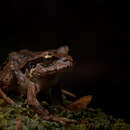Brief Summary
provided by IABIN
Diagnosis Moderate sized species (males 31.4-35.2 mm snout-vent length; females 33.7-41.2 mm snout-vent length) that can be distinguished from its congeners by the following combination of characters: 1) upper part of the iris bronze-yellow; 2) distal portion of the fingers and toes rounded and prominent; 3) prevomers in narrow contact; 4) snout pointed in dorsal and lateral view, noticeably protruding over the lower jaw.
- author
- Esteban O. Lavilla
- editor
- Diego Arrieta
Distribution
provided by IABIN
From Valdivia to Wellington Island in Puerto Eden, Chile to Tromen Lake and Puelo Lake in Argentina.
- author
- Esteban O. Lavilla
- editor
- Diego Arrieta
Diagnostic Description
provided by IABIN
Adult Morphology Head wider than long. Snout pointed in dorsal view, rounded in lateral profile; canthus rostralis well defined; loreal region concave, sloping slightly to lip; nostrils lateral, closer to tip of snout than to orbit; length of eye greater than distance between eye and nostril; interorbital distance slightly narrower than length of eye, greater than internarial distance. Tympanic membrane small and poorly defined, tympanum diameter smaller than eye diameter. Lateral fold present, from behind eye to middle part of body. Tongue rounded, slightly cordiform. Small round choanae; dentigerous process of prevomers lying slightly below choanae; closer medially, transverse or slightly oblique, each process bearing 4-6 teeth. Forelimbs thin, first finger equal in length to second; third finger much longer than fourth; digital length in decreasing order III,-IV,-II-I. Tips of fingers rounded and slightly prominent. Two palmar tubercles ovoid and prominent; subarticular tubercles rounded and moderate prominent; supernumerary palmar tubercles absent. Hind limbs slender, tibiotarsal articulation reaching to middle of eye. Toes long, slender, not fringed; in decreasing order of length IV-(V,III)-II-I. Outer metatarsal tubercle ovoid and prominent, inner metatarsal tubercle small. Subarticular tubercles large, conical and prominent; supernumerary tubercles absent. Tarsal fold absent. Rudiment of web between fourth and third, and between third and second toes. Anal opening oriented transversely at dorsal level of thighs. Skin smooth, minute tubercles on head. Ventral surface of thighs without granular tubercles, sometimes with minute tubercles. Two short cutaneous spurs at the heels and two dorsal linear ridges convergent behind, which are hardly noticeable. Minute tubercles on posterior part of flanks. Dorsum dark gray, with a remarkable pattern like a butterfly or hourglass extending from head, between eyes, to middle of dorsum. On flanks a dark fringe reaching the eyes. Some specimens show a narrow mid-line. Minute dark spots lateral to the butterfly pattern; two rounded dark brown spots on lumbar area stand out on the background. Minute dark spots on whitish venter, most numerous on throat. Arms, thighs, shanks, and tarsi barred dark brown. In life, dorsum and limbs light brown, tan or gray, venter whitish. Markings on dorsum, venter and limbs dark brown or black, flanks sometimes light brown or dark orange and the spots brown. Upper part of iris bronze-yellow, lower part dark brown. Larval morphology Larvae in stage 38 (Gosner, 1960) have the body ovoid in lateral view, two times longer than deep; dorsal contour gradually curved from middle of body to snout. Eyes directed anterodorsolaterally, separated by a distance 1.4 times the eye diameter. Nostrils small situated midway between eye and tip of snout.Mouth small and anteromedial, labial papillae interrupted anteriorly, denticles absent, beak little developed. The specimens from both localities show a rudimentary cornified horny beak. Anal tube medial; no spiracle but a small ventrolateral fissure on the left side of the body. Caudal musculature moderately robust, dorsal and ventral fins well developed; end of the tail rounded. Dorsal fin beginning on the second third of the body. Color in life creamy white, abdomen and fins transparent, internal organs visible. Dorsal area with scarce minute melanophores. Color in formalin similar to that in life.
- author
- Esteban O. Lavilla
- editor
- Diego Arrieta
Eupsophus calcaratus: Brief Summary
provided by wikipedia EN
Eupsophus calcaratus (common name: Chiloe Island ground frog) is a species of frog in the family Alsodidae. It is endemic to Patagonia (southern Argentina and Chile). It has one of the broadest distributions of any Chilean frog.
- license
- cc-by-sa-3.0
- copyright
- Wikipedia authors and editors

